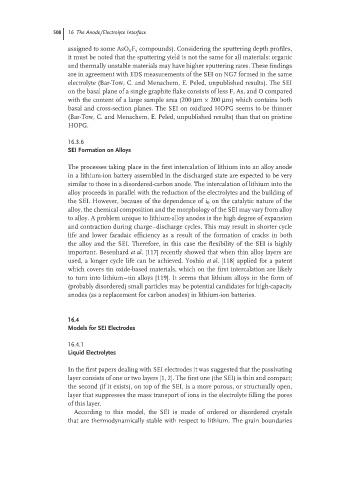Page 535 - Handbook of Battery Materials
P. 535
508 16 The Anode/Electrolyte Interface
assigned to some AsO x F y compounds). Considering the sputtering depth profiles,
it must be noted that the sputtering yield is not the same for all materials; organic
and thermally unstable materials may have higher sputtering rates. These findings
are in agreement with EDS measurements of the SEI on NG7 formed in the same
electrolyte (Bar-Tow, C. and Menachem, E. Peled, unpublished results). The SEI
on the basal plane of a single graphite flake consists of less F, As, and O compared
with the content of a large sample area (200 µm × 200 µm) which contains both
basal and cross-section planes. The SEI on oxidized HOPG seems to be thinner
(Bar-Tow, C. and Menachem, E. Peled, unpublished results) than that on pristine
HOPG.
16.3.6
SEI Formation on Alloys
The processes taking place in the first intercalation of lithium into an alloy anode
in a lithium-ion battery assembled in the discharged state are expected to be very
similar to those in a disordered-carbon anode. The intercalation of lithium into the
alloy proceeds in parallel with the reduction of the electrolytes and the building of
the SEI. However, because of the dependence of i 0 on the catalytic nature of the
alloy, the chemical composition and the morphology of the SEI may vary from alloy
to alloy. A problem unique to lithium-alloy anodes is the high degree of expansion
and contraction during charge–discharge cycles. This may result in shorter cycle
life and lower faradaic efficiency as a result of the formation of cracks in both
the alloy and the SEI. Therefore, in this case the flexibility of the SEI is highly
important. Besenhard et al. [117] recently showed that when thin alloy layers are
used, a longer cycle life can be achieved. Yoshio et al. [118] applied for a patent
which covers tin oxide-based materials, which on the first intercalation are likely
to turn into lithium–tin alloys [119]. It seems that lithium alloys in the form of
(probably disordered) small particles may be potential candidates for high-capacity
anodes (as a replacement for carbon anodes) in lithium-ion batteries.
16.4
Models for SEI Electrodes
16.4.1
Liquid Electrolytes
In the first papers dealing with SEI electrodes it was suggested that the passivating
layer consists of one or two layers [1, 2]. The first one (the SEI) is thin and compact;
the second (if it exists), on top of the SEI, is a more porous, or structurally open,
layer that suppresses the mass transport of ions in the electrolyte filling the pores
of this layer.
According to this model, the SEI is made of ordered or disordered crystals
that are thermodynamically stable with respect to lithium. The grain boundaries

